In the world of traditional instruments, few possess the haunting beauty and spiritual depth of the Native American drone flute.
This remarkable instrument, with its mesmerizing dual-chamber design, creates an otherworldly soundscape that has captivated musicians, healers, and spiritual seekers for generations.
Unlike its single-chambered cousin, the Native American flute with drone produces a layered, harmonious resonance that seems to bridge the earthly and the divine.
The growing fascination with Native American drone flute music extends far beyond cultural appreciation.
Modern practitioners of meditation, sound healing, and ambient music have discovered that this traditional Native American instrument offers something uniquely powerful—a sonic experience that can transport listeners into deep states of relaxation and spiritual connection.
Whether you’re a seasoned musician exploring world instruments or someone seeking the therapeutic benefits of sound healing, the drone flute Native American tradition offers a profound journey into both musical and spiritual realms.
This comprehensive guide will take you through every aspect of the Native American drone flute, from its ancient origins among indigenous tribes to modern applications in contemporary music.
You’ll discover the intricate craftsmanship behind these sacred instruments, learn about the spiritual significance embedded in their design, and gain practical knowledge about playing techniques, purchasing considerations, and proper care.
Most importantly, we’ll explore how to approach this instrument with the cultural respect and authenticity it deserves.
What Is a Native American Drone Flute?
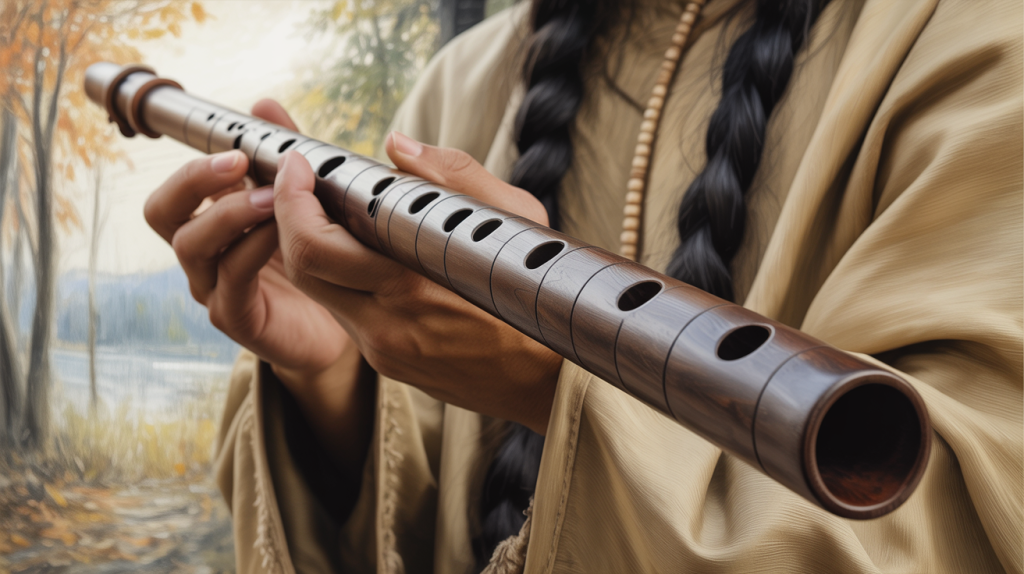
The Native American drone flute represents one of the most sophisticated developments in indigenous wind instrument design.
At its core, this double chamber Native flute consists of two distinct pipes joined together: a melody chamber and a drone chamber.
This innovative design creates what musicians call a “harmonic drone”—a continuous, resonant note that provides a rich foundation for melodic exploration above.
The Architecture of Sound
The fundamental difference between a standard Native American flute and a drone flute lies in this dual-chamber construction.
While traditional Native American flutes produce beautiful single-line melodies, the Native double flute adds an entirely new dimension of harmonic depth.
The drone chamber typically produces a lower, sustained note that remains constant while the player creates melodies on the primary chamber. This creates an instant ensemble effect, as if two musicians are playing in perfect harmony.
The physical construction involves careful attention to bore diameter, chamber length, and the precise relationship between the two pipes.
Master craftspeople spend years perfecting the mathematical relationships that create optimal resonance between the chambers.
The result is an instrument capable of producing complex overtones and harmonics that seem to resonate not just in the air, but within the listener’s very being.
Tonal Characteristics and Scale Systems
Most Native American drone flutes are crafted in minor pentatonic scales, though variations exist across different tribal traditions.
The minor pentatonic scale—consisting of five notes that create inherently pleasing intervals—makes the instrument accessible to beginners while offering endless possibilities for advanced players.
Common keys include A minor, G minor, and F# minor, each offering different emotional qualities and playing characteristics.
The drone note itself is typically tuned to the root or fifth of the scale, creating a harmonic foundation that supports the melody without competing with it.
This relationship between drone and melody reflects deep understanding of acoustic principles that indigenous makers developed over centuries of refinement.
History and Cultural Significance of the Native American Drone Flute
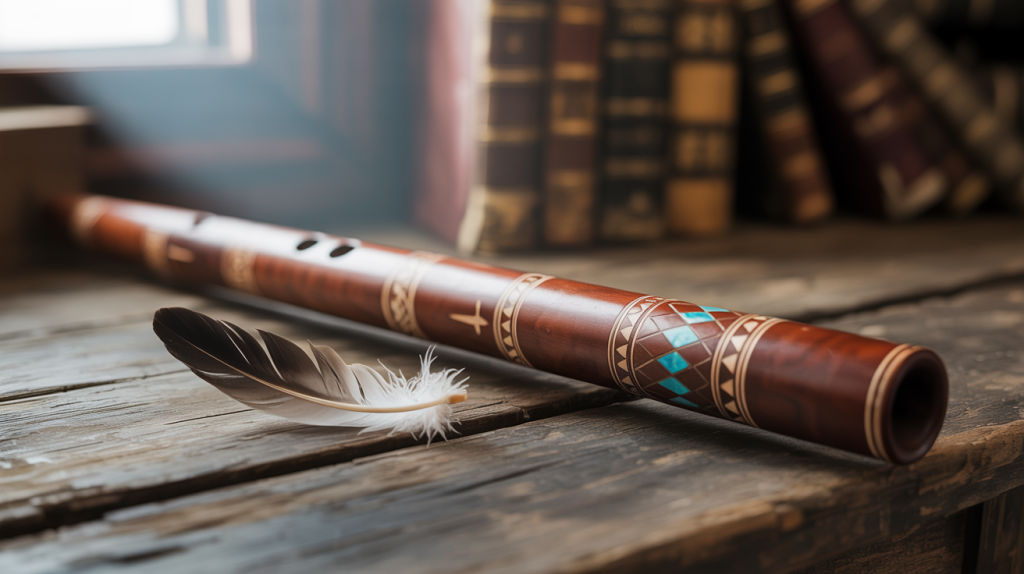
Ancient Origins and Tribal Traditions
The history of Native American drone flute traditions stretches back hundreds of years, with archaeological evidence suggesting that various forms of multi-chambered flutes existed among numerous tribes across North America.
While the exact origins remain shrouded in the mists of oral tradition, what’s clear is that these instruments held profound spiritual and ceremonial significance far beyond mere entertainment.
Different tribes developed their own variations and approaches to the drone flute concept. Plains tribes often used longer instruments with deeper, more resonant drone chambers, while Woodland tribes sometimes favored shorter, higher-pitched versions.
The Lakota, Cherokee, and Navajo traditions each contributed unique elements to the evolving design and playing techniques we recognize today.
Archaeological discoveries have revealed flute fragments and artistic depictions that suggest the use of paired or multi-chambered flutes in various ceremonial contexts.
These findings indicate that the concept of combining drone and melody was not a modern innovation but rather an ancient understanding of how sound could be used to create altered states of consciousness and spiritual connection.
Spiritual and Ceremonial Applications
In Native American spirituality, the drone flute served multiple sacred purposes. The continuous drone note was often interpreted as the voice of the Earth itself—a constant reminder of the connection between human expression and the natural world.
This symbolic relationship made the instrument particularly valuable in ceremonies focused on healing, vision quests, and communication with the spirit world.
Healing Native American flute ceremonies often incorporated the drone’s ability to create what modern sound therapists call “entrainment”—the tendency for human brainwaves to synchronize with consistent rhythmic or tonal patterns.
Tribal healers intuitively understood that the combination of steady drone and flowing melody could induce deeply therapeutic states of consciousness.
The instrument also played crucial roles in storytelling traditions. The drone provided a sonic backdrop that could represent the eternal, unchanging aspects of existence—the mountains, the earth, the constant presence of the Creator—while the melody told the stories of human experience, change, and growth.
Symbolism and Spiritual Meaning
Within traditional Native American worldviews, the dual nature of the drone flute carried rich symbolic meaning.
The drone chamber often represented the feminine principle—steady, nurturing, and constant—while the melody chamber embodied the masculine principle of active change and expression. Together, they created a musical representation of the balance essential to all life.
This symbolism extended to the breath itself, which was considered sacred in most Native traditions.
The act of playing the drone flute became a form of prayer, with each breath carrying intention and each note expressing gratitude or petition to the spirit world.
The player became a conduit between the earthly and spiritual realms, channeling both personal expression and universal connection through the instrument.
The wood used in construction also carried spiritual significance. Cedar, revered for its purifying properties, was often chosen for its ability to enhance the spiritual qualities of the music.
The act of creating the instrument itself was ceremonial, with makers offering prayers and blessings throughout the construction process.
Materials and Craftsmanship in Drone Flute Construction
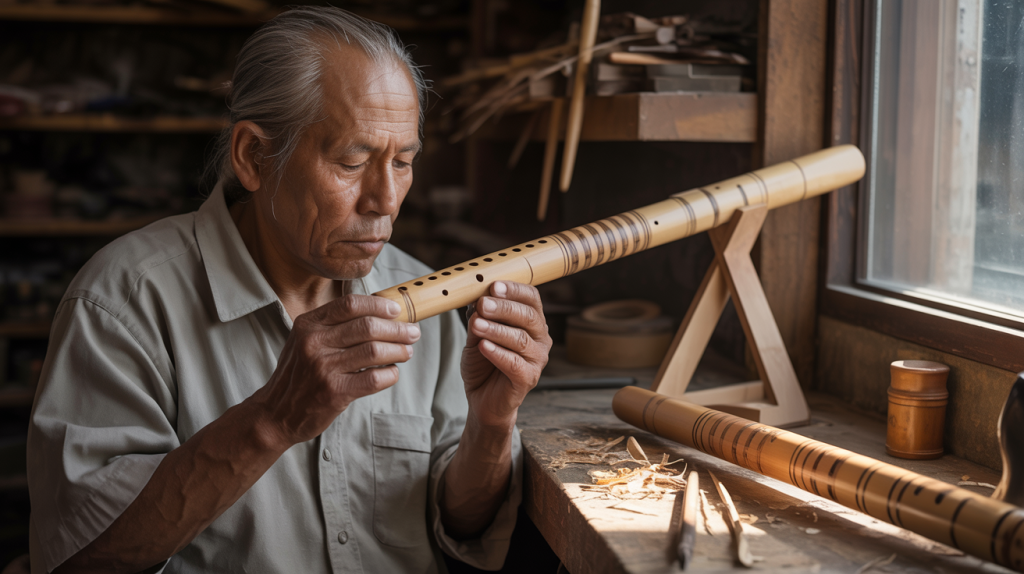
Traditional Woods and Their Acoustic Properties
The choice of wood fundamentally shapes both the sound quality and spiritual resonance of a Native American drone flute.
Traditional makers understood that different woods contributed distinct tonal characteristics, and this knowledge was passed down through generations of craftspeople.
Cedar remains the most revered wood for traditional Native American flutes. Western Red Cedar, in particular, offers a warm, mellow tone with excellent resonance characteristics.
The wood’s natural oils contribute to its legendary resistance to moisture and temperature changes, making it ideal for the demanding acoustic requirements of drone chamber construction.
Beyond its practical benefits, cedar holds deep spiritual significance in many tribal traditions, associated with purification, protection, and connection to the spirit world.
Walnut provides a different acoustic signature, offering stronger fundamental tones and more pronounced overtones.
This hardwood creates instruments with exceptional projection and clarity, making them ideal for ceremonial settings where the music needs to carry over larger spaces. The dense grain structure of walnut also allows for more intricate carving and decorative work.
Birch offers lighter weight and brighter tonal qualities, often preferred for higher-pitched drone flutes. Its fine, even grain makes it excellent for beginners who need responsive instruments that are easy to play and maintain. The wood’s natural resilience also makes birch flutes particularly suitable for travel and frequent use.
Modern artisans have expanded the palette to include exotic hardwoods like rosewood, padauk, and zebrawood. While these materials can produce stunning visual and acoustic results, traditional makers emphasize that the spiritual connection to the wood often matters more than exotic appearance.
Hand-Carving Techniques and Artistic Elements
The creation of a Native American drone flute represents one of the most demanding challenges in traditional woodworking.
Unlike mass-produced instruments, authentic drone flutes require precise hand-carving to achieve the complex internal geometries necessary for proper drone-to-melody balance.
Master craftspeople begin with seasoned wood that has been air-dried for several years. The process starts with carefully splitting the wood along natural grain lines, then hollowing out the internal chambers using traditional tools and techniques passed down through generations.
The critical challenge lies in creating two separate chambers with precisely calculated internal dimensions while maintaining the structural integrity of the joined instrument.
The bore size, chamber length, and finger hole placement must be mathematically precise to achieve proper tuning relationships between the drone and melody chambers.
Traditional makers often rely on intuitive understanding developed over decades of practice, making minute adjustments based on how the wood responds during the carving process.
Decorative elements serve both aesthetic and spiritual purposes. Traditional patterns often incorporate tribal symbols, animal totems, and geometric designs that carry cultural meaning.
These carvings are not merely ornamental but represent the maker’s spiritual connection to the instrument and its intended purpose.
Modern Innovation and Traditional Authenticity
Contemporary Native American flute makers face the challenge of honoring traditional methods while incorporating modern tools and techniques that can improve consistency and accessibility.
Many authentic makers use a combination of traditional hand-carving and modern precision tools to achieve the exacting tolerances required for quality drone chamber construction.
The key distinction lies in maintaining the spiritual and cultural integrity of the construction process. Authentic makers still begin each instrument with ceremony and intention, treating the creation process as a sacred act rather than mere manufacturing.
This approach ensures that the finished instrument carries not just excellent acoustic properties but also the spiritual essence that makes Native American drone flutes truly transformative instruments.
The Unique Sound of the Native American Drone Flute
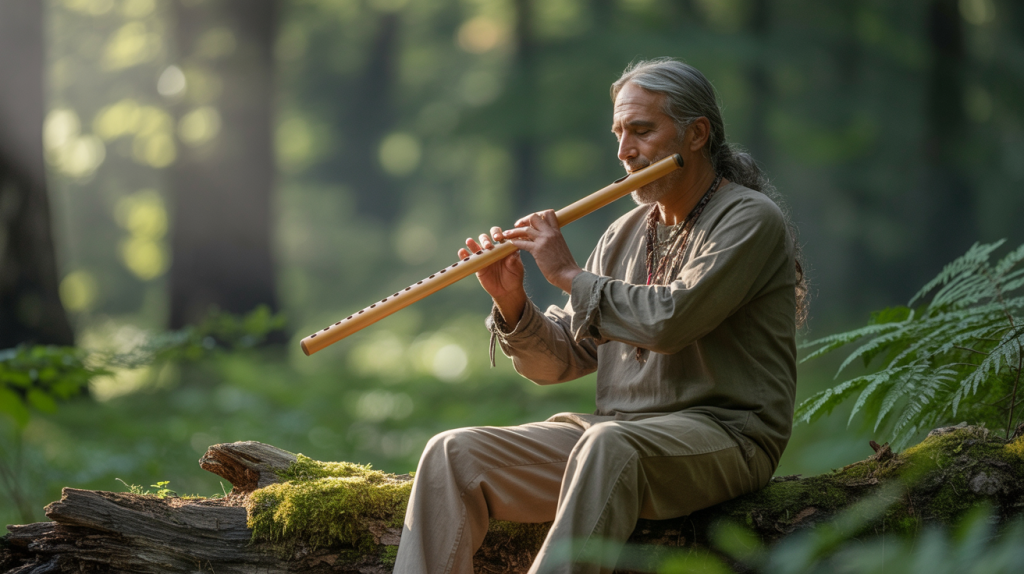
Acoustic Principles and Harmonic Resonance
The Native American drone flute sound represents a masterpiece of acoustic engineering developed through centuries of refinement.
The instrument’s ability to produce complex harmonic relationships stems from the precise mathematical relationships between the two chambers and their interaction with the player’s breath and fingering techniques.
When both chambers are played simultaneously, the drone note provides what acousticians call a “fundamental frequency”—a stable harmonic foundation that allows the melody notes to create natural overtones and beating patterns.
This creates the characteristic “shimmer” that experienced players can achieve, where the interaction between drone and melody produces subtle frequency variations that seem to make the sound breathe and pulse with life.
The physics behind this effect involves the principle of harmonic resonance. When two tones with specific mathematical relationships are played together, they create additional frequencies called “difference tones” and “summation tones.”
These phantom frequencies, audible to the listener but not directly produced by either chamber, contribute to the instrument’s renowned ability to induce altered states of consciousness and deep relaxation.
The length and diameter of each chamber determine not only the pitch but also the timbral qualities of the sound. Longer chambers produce deeper, more resonant tones with richer overtone content, while shorter chambers create brighter, more penetrating sounds.
Master makers understand how to balance these characteristics to create instruments suitable for different musical and therapeutic applications.
Sound Healing and Therapeutic Applications
Modern sound healing practitioners have discovered that the Native American drone flute possesses unique therapeutic qualities that distinguish it from other instruments.
The combination of sustained drone and flowing melody creates what researchers call “binaural beating” when listened to through headphones or in acoustic spaces with good resonance.
Binaural beats occur when two slightly different frequencies are presented to each ear, causing the brain to perceive a third tone that pulses at the difference between the two frequencies.
This phenomenon can influence brainwave patterns, potentially inducing states of deep relaxation, enhanced creativity, or meditative awareness.
The drone component provides consistency and grounding, which many therapists find essential for clients dealing with anxiety, trauma, or emotional instability.
The steady, unchanging drone note can serve as an anchor point for consciousness, allowing the mind to relax while the melodic variations provide gentle stimulation that maintains engagement without overwhelming the nervous system.
Research in neuromusicology suggests that the specific frequency relationships common in traditional Native American scales may have evolved to optimize their therapeutic effects.
The minor pentatonic scale, with its emphasis on perfect fifths and minor thirds, creates naturally calming interval relationships that seem to resonate with human emotional and physiological systems.
Comparison with Other Drone Instruments
The Native American drone flute shares certain characteristics with other traditional drone instruments from around the world, yet maintains its unique voice and cultural identity.
Understanding these relationships helps appreciate the universal human attraction to drone-based music while honoring the specific contributions of indigenous American traditions.
The didgeridoo from Australian Aboriginal traditions creates a similar continuous tone foundation, but achieves this through circular breathing techniques rather than dual-chamber construction.
While both instruments can induce trance-like states, the didgeridoo’s overtone-rich sound contrasts with the more melodically oriented approach of the Native American drone flute.
Overtone singing traditions from Tibet and Tuva create multiple simultaneous tones using vocal techniques, producing effects similar to the drone flute’s harmonic layering.
However, the breath-based intimacy of the flute creates a different kind of meditative experience, one that many practitioners find more accessible and sustainable for extended practice.
The shruti box from Indian classical music provides a mechanical drone using reeds or electronic means, offering consistent harmonic support for melodic instruments.
While functionally similar to the drone flute’s harmonic foundation, the organic, breath-powered nature of the Native American instrument creates a more dynamic and expressive relationship between player and drone.
What distinguishes the Native American drone flute from these other traditions is its integration of both drone and melody into a single instrument played by one person.
This creates a unique musical and spiritual experience where the player becomes both the harmonic foundation and the melodic voice, embodying the balance between stability and change that characterizes much of Native American spiritual philosophy.
How to Play the Native American Drone Flute
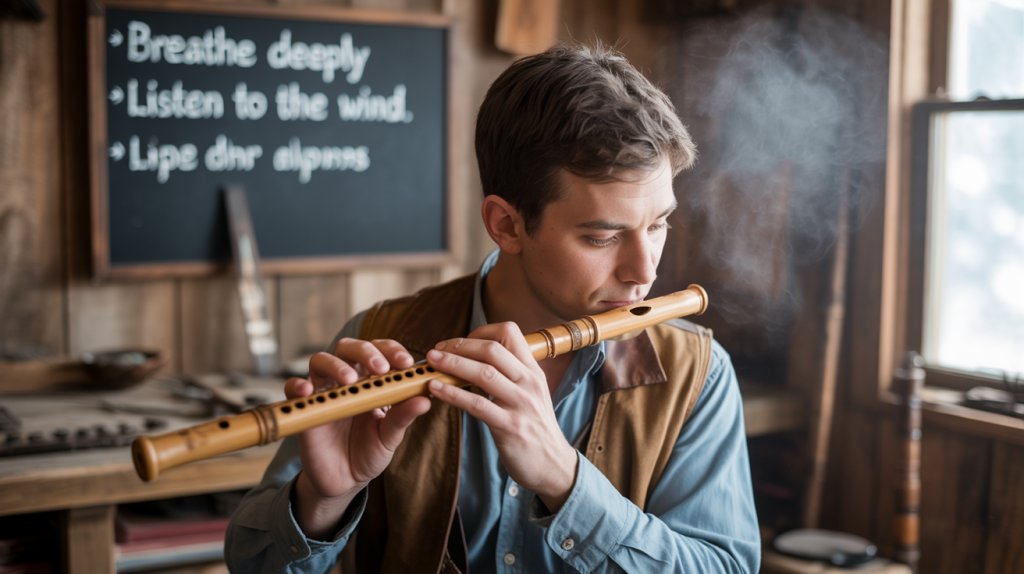
Fundamental Breath Control and Embouchure
Learning to play the Native American drone flute begins with mastering the breath control techniques that make the dual-chamber system possible.
Unlike single-chamber flutes where breath management is relatively straightforward, the drone flute requires the player to maintain consistent air pressure to both chambers while having enough control to create expressive melodies.
The foundational technique involves developing what experienced players call “circular awareness” of breath flow.
This means learning to sense how air moves through both chambers simultaneously and adjusting the breath pressure to maintain the drone while allowing melodic expression.
Beginning players often find it helpful to start by playing each chamber separately before attempting to combine them.
Embouchure development focuses on creating a relaxed, open mouth position that allows efficient air flow without excessive tension.
The lips should form a gentle seal around the mouthpiece, similar to blowing across the top of a bottle, but with more awareness of how breath direction affects each chamber.
Many teachers recommend practicing long tones on each chamber separately to develop the muscle memory necessary for consistent tone production.
Breath support techniques drawn from traditional wind instrument pedagogy apply to drone flute playing, but with adaptations for the instrument’s unique requirements.
Diaphragmatic breathing provides the steady air stream necessary for drone maintenance, while controlled exhalation allows for dynamic expression in the melody line.
Advanced players develop the ability to vary air pressure independently for each chamber, creating subtle interactions between drone and melody.
Fingering Techniques and Scale Patterns
The fingering system for Native American drone flutes follows the same basic principles as standard Native American flutes, but with additional considerations for how finger movements affect both chambers.
Most instruments use a six-hole fingering pattern based on the minor pentatonic scale, though some makers create instruments with additional holes for chromatic possibilities.
Basic scale patterns should be learned thoroughly before attempting more complex melodic work. The minor pentatonic scale provides a natural foundation that sounds pleasing regardless of which notes are combined, making it ideal for beginner exploration.
Practice should begin with simple ascending and descending patterns, focusing on clean hole coverage and smooth transitions between notes.
Drone chamber management requires learning when and how to engage the drone effectively. Some players prefer to maintain the drone constantly, creating a continuous harmonic foundation, while others use it selectively for emphasis or to create specific emotional effects. The choice often depends on the musical context and the player’s artistic intentions.
Advanced fingering techniques include partial hole coverage for microtonal effects, cross-fingerings for notes outside the basic scale, and techniques for creating vibrato and other ornamental effects.
These skills develop gradually as players become more comfortable with basic technique and begin exploring the instrument’s full expressive potential.
Practice Routines for Meditative Soundscapes
Developing proficiency on the Native American drone flute requires practice approaches that honor both technical development and the instrument’s spiritual dimensions.
Unlike classical Western instruments where technical exercises dominate early training, drone flute practice often emphasizes meditative exploration and intuitive musical development.
Daily practice sessions might begin with simple breath awareness exercises, focusing on the sensation of air moving through the instrument and the vibrations created in both chambers.
This meditative approach helps develop the relaxed awareness necessary for expressive playing while building the physical skills needed for technical proficiency.
Drone sustaining exercises help build the breath control and embouchure stability necessary for maintaining consistent harmonic foundations.
Practice holding single drone notes for extended periods, focusing on tone quality and stability rather than duration.
Gradually add simple melodic patterns over the sustained drone, starting with single notes and building to more complex phrases.
Improvisation practice forms the heart of traditional Native American flute pedagogy. Rather than learning predetermined pieces, players are encouraged to explore the scale patterns intuitively, allowing melodies to emerge from the interaction between breath, intention, and the instrument’s acoustic properties.
This approach develops both technical skills and the spiritual connection that makes drone flute playing truly transformative.
Recording and reflection can enhance practice effectiveness by allowing players to hear their progress objectively and identify areas for improvement.
Many players find that recording their meditative practice sessions reveals musical ideas and patterns that weren’t consciously apparent during playing.
Tips from Experienced Players
Master players of the Native American drone flute often emphasize principles that extend beyond technical instruction into the realm of spiritual and artistic development.
These insights, gathered from years of dedicated practice and teaching, can accelerate the learning process while ensuring that technical development serves the instrument’s deeper purposes.
Listen to the silence between notes as much as the notes themselves. The spaces in drone flute music often carry as much meaning as the sounds, creating opportunities for the harmonics and overtones to develop and resolve.
This awareness of musical space reflects the meditative nature of the instrument and helps players develop a more nuanced musical sensitivity.
Allow the instrument to teach you rather than imposing preconceived musical ideas. Many experienced players describe a process of discovery where the flute reveals its musical possibilities through patient exploration.
This approach requires setting aside ego-driven achievement goals in favor of receptive listening and response to what the instrument offers.
Practice in different acoustic environments to understand how the drone flute’s sound interacts with various spaces.
The instrument sounds dramatically different in small, intimate rooms compared to large, resonant spaces or outdoor environments.
This experiential learning helps players develop adaptability and appreciation for the instrument’s acoustic properties.
Integrate breath awareness practices from meditation traditions to deepen the spiritual dimensions of playing.
Many players find that formal breathing practices from yoga, qigong, or other traditions enhance their flute practice and vice versa, creating a mutually reinforcing cycle of development.
Drone Flutes in Modern Music and Contemporary Applications
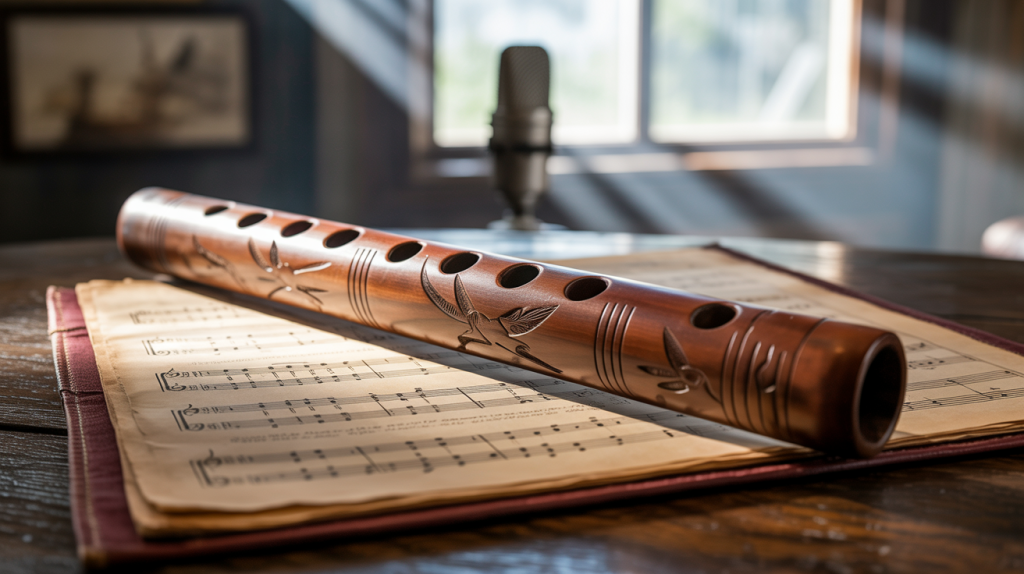
New Age and Ambient Music Integration
The Native American drone flute has found a natural home in contemporary new age and ambient music genres, where its meditative qualities and rich harmonic content serve both artistic and therapeutic purposes.
Modern recording artists have discovered that the instrument’s ability to create instant atmospheric depth makes it invaluable for soundscape composition and meditation music production.
Studio recording techniques for drone flutes often emphasize the instrument’s natural reverb and harmonic complexity.
Many producers use minimal processing, allowing the organic acoustic properties to shine through while adding subtle environmental reverbs that enhance the meditative quality.
The dual-chamber nature of the instrument provides natural stereo imaging opportunities, with some engineers recording each chamber separately for maximum mixing flexibility.
Ambient music composition frequently builds entire pieces around the drone flute’s harmonic foundation, layering additional instruments and electronic textures over the acoustic base.
The instrument’s inherent ability to sustain long tones makes it ideal for creating the extended musical structures characteristic of ambient genres, while the melodic chamber provides opportunities for development and variation within these sustained environments.
Meditation and wellness applications have driven significant growth in drone flute recording and performance.
Yoga studios, meditation centers, and therapeutic practices increasingly incorporate live drone flute music or recordings into their programming.
The instrument’s ability to induce relaxed awareness states makes it particularly valuable for guided meditation, bodywork sessions, and stress reduction programs.
World Music Fusion and Collaboration
Contemporary world music artists have embraced the Native American drone flute as a bridge between traditional indigenous music and global fusion styles.
This cross-cultural integration has created new musical vocabularies while maintaining respect for the instrument’s cultural origins and spiritual significance.
Guitar and drone flute combinations have proven particularly popular, with the guitar’s harmonic versatility complementing the flute’s melodic and drone capabilities.
Acoustic fingerstyle guitarists often use altered tunings that align with the flute’s pentatonic scales, creating seamless integration between the instruments.
Electric guitar players explore ambient and atmospheric textures that support rather than compete with the flute’s meditative qualities.
Percussion integration draws from multiple traditions, combining Native American frame drums with cajons, tabla, didgeridoos, and electronic percussion to create rhythmic foundations that support extended drone flute explorations.
The key to successful integration lies in understanding that the drone flute typically functions best with subtle, supportive rhythmic accompaniment rather than complex or aggressive percussion patterns.
Electronic music collaboration has opened entirely new possibilities for drone flute expression. Digital artists sample and loop drone flute performances, creating layered compositions that extend the instrument’s harmonic possibilities infinitely.
Real-time processing using reverbs, delays, and harmonic enhancement can transform live drone flute performance into immersive sonic environments that retain the instrument’s organic essence while expanding its sonic palette.
Film Scoring and Atmospheric Applications
The entertainment industry has discovered the Native American drone flute’s unique ability to create emotional depth and atmospheric authenticity in visual media.
Film composers, video game sound designers, and documentary producers increasingly turn to the instrument when seeking sounds that evoke spirituality, connection to nature, or indigenous cultural themes.
Cinematic scoring applications often use the drone flute to establish emotional undertones or cultural context without overwhelming dialogue or action.
The instrument’s ability to sustain long tones makes it ideal for creating emotional continuity across scene transitions, while the melodic chamber can provide thematic development that supports narrative progression.
Documentary film integration frequently features drone flute music in productions dealing with environmental themes, indigenous rights, or spiritual topics.
The instrument’s cultural authenticity and natural sound quality provide credibility while avoiding the clichéd “generic ethnic” sounds that can diminish documentary impact.
Gaming and interactive media applications exploit the drone flute’s meditative qualities for exploration sequences, puzzle-solving environments, and spiritual or mystical game elements.
The instrument’s ability to loop seamlessly makes it ideal for interactive applications where music must adapt to variable timing and player actions.
Buying Guide: Choosing Your Native American Drone Flute
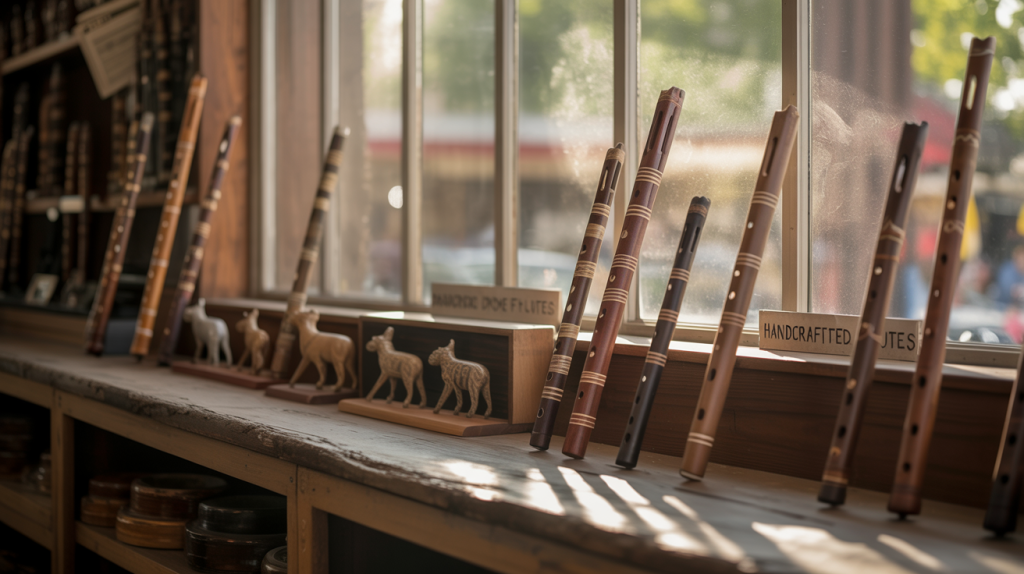
Understanding Size, Scale, and Key Relationships
Selecting the right Native American drone flute requires understanding how the instrument’s physical dimensions affect both playability and musical characteristics.
Unlike mass-produced instruments with standardized specifications, handcrafted drone flutes vary significantly in size, scale, and tonal qualities, making informed selection essential for satisfaction and musical success.
Flute length and pitch relationships determine both the fundamental key and the playing characteristics of the instrument.
Longer flutes produce lower pitches with deeper, more resonant drone chambers, while shorter instruments offer higher pitches with brighter, more penetrating tones.
Most players find that instruments in the 18-24 inch range provide a good balance of comfortable playability and rich tonal characteristics.
Key selection should align with your musical goals and physical capabilities. Lower keys like G and A offer deeper, more meditative qualities but require more breath support and larger hand spans for comfortable fingering.
Higher keys like D and E are often easier for beginners to play and integrate well with other instruments in ensemble settings.
Scale variations beyond the standard minor pentatonic offer expanded musical possibilities but may require more advanced technique.
Some makers offer instruments with additional holes for chromatic notes, while others provide scales from specific tribal traditions. Consider your musical background and goals when evaluating these options.
Drone tuning relationships vary among makers and can significantly affect the instrument’s musical character.
Some prefer drone tunings based on the root note of the scale, while others use fifth relationships or other intervals.
Understanding these relationships helps ensure that your chosen instrument will produce the harmonic effects you desire.
Material Selection and Sound Quality Considerations
The wood selection for your Native American drone flute affects not only the sound quality but also the instrument’s durability, maintenance requirements, and cultural authenticity.
Understanding the characteristics of different materials helps ensure that your investment provides long-term satisfaction and musical growth.
Cedar varieties remain the gold standard for traditional authenticity and tonal quality. Western Red Cedar offers warm, resonant tones with excellent projection, while Eastern Red Cedar provides slightly brighter characteristics with enhanced high-frequency response.
Both species offer good durability and resistance to climate changes, making them excellent choices for regular players.
Hardwood options like walnut, cherry, and maple provide different tonal signatures and often enhanced durability.
Walnut is particularly prized for its balanced tonal characteristics and beautiful grain patterns, while cherry offers slightly warmer tones with excellent aging characteristics.
These materials typically command higher prices but offer increased longevity and often superior acoustic properties.
Exotic wood considerations should balance aesthetic appeal with practical playability. While instruments made from bubinga, padauk, or other exotic species can be visually stunning, ensure that the maker has experience with these materials and that the acoustic properties align with your musical goals.
Finishing and treatment affect both appearance and longevity. Traditional oil finishes enhance the wood’s natural beauty while allowing the instrument to age gracefully, but require more maintenance than modern polyurethane finishes. Consider your maintenance preferences and playing frequency when evaluating finishing options.
Price Ranges and Value Assessment
Native American drone flute pricing reflects the complex interplay of materials, craftsmanship, maker reputation, and cultural authenticity.
Understanding these factors helps ensure that your investment provides appropriate value for your needs and budget level.
Entry-level instruments ($150-$400) typically feature basic wood selections and simpler construction techniques while maintaining playability and authentic sound characteristics.
These instruments serve well for beginners exploring the instrument’s possibilities or experienced players seeking travel instruments or backup options.
Mid-range options ($400-$800) usually feature premium wood selections, more refined craftsmanship, and enhanced aesthetic elements.
These instruments often represent the sweet spot for serious players, offering professional-quality sound and construction without the premium pricing of master-level instruments.
Premium handcrafted flutes ($800-$2000+) showcase the highest levels of craftsmanship, materials, and artistic design.
These instruments often feature exotic woods, intricate carving, and construction techniques that can take weeks or months to complete.
Master-level instruments justify their pricing through superior acoustic properties, artistic beauty, and cultural authenticity.
Custom instruments command premium pricing but offer the opportunity to specify exactly the characteristics you desire.
Working with experienced makers to create custom instruments can result in perfect alignment between the flute’s properties and your musical goals, though this process requires patience and clear communication about your preferences.
Identifying Authentic Makers and Avoiding Mass Production
The growing popularity of Native American flutes has unfortunately led to mass production of instruments that lack cultural authenticity and often suffer from poor construction quality.
Identifying authentic makers and avoiding culturally inappropriate copies requires research and attention to specific markers of authenticity.
Native American maker certification provides the strongest guarantee of cultural authenticity. Many authentic makers are enrolled tribal members who learned their craft through traditional apprenticeship or family traditions. Look for makers who can provide information about their tribal affiliation and training background.
Craftsmanship indicators distinguish handmade instruments from mass-produced copies. Authentic instruments show subtle variations in carving, finishing, and proportions that reflect individual maker techniques.
Mass-produced instruments often display unnaturally uniform characteristics and machine tooling marks.
Cultural sensitivity markers include appropriate use of traditional designs, respectful marketing language, and maker knowledge about the cultural significance of the instruments they create.
Avoid sellers who market flutes as “sacred objects” without proper cultural context or who use stereotypical imagery that trivializes Native American culture.
Online marketplace considerations require extra vigilance when purchasing instruments sight unseen.
Reputable makers typically provide detailed photographs, construction information, and often audio samples of their instruments.
Be wary of sellers who cannot provide specific information about construction techniques, materials, or their background in flute making.
Care, Maintenance, and Longevity
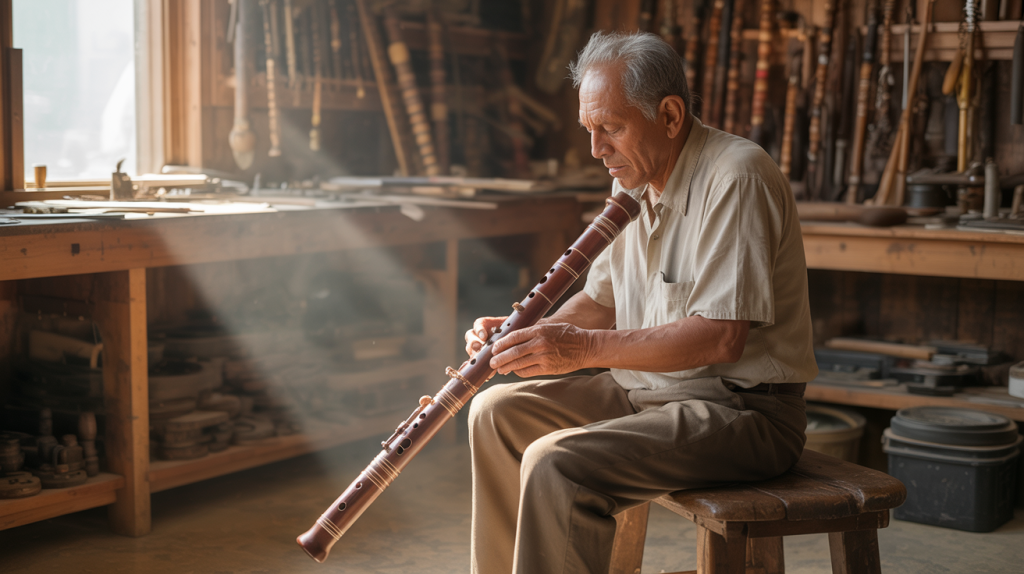
Daily Care and Cleaning Protocols
Proper maintenance of your Native American drone flute ensures not only optimal sound quality but also longevity that can span generations.
The dual-chamber construction of drone flutes creates additional considerations beyond standard flute care, requiring attention to both chambers and their interaction.
Post-playing cleaning should become a consistent ritual after each playing session. The dual chambers require individual attention, as moisture and condensation can affect each chamber differently.
Use a soft, lint-free cloth or specialized flute cleaning rod to gently swab each chamber, removing moisture that could affect tuning or promote wood degradation.
Bore maintenance requires particular attention in drone flutes due to the precision required for proper harmonic relationships between chambers.
Any buildup of residue or changes in bore dimensions can affect the delicate tuning relationships that make the instrument functional.
Many experienced players use specialized flute oils sparingly to maintain bore condition without over-saturating the wood.
External cleaning should preserve both the wood’s natural characteristics and any decorative elements. Use clean, dry cloths to remove fingerprints and surface moisture, paying special attention to finger holes and any carved decorative elements where oils and debris can accumulate. Avoid chemical cleaners that might react with wood finishes or traditional treatments.
Assembly and disassembly considerations apply to instruments designed for portability. Some drone flutes feature removable sections for travel, requiring careful attention to joint alignment and seal integrity.
Always store joint sections properly and inspect connection points regularly for wear or damage that could affect air seal and tuning.
Climate Control and Storage Solutions
Wood instruments are particularly sensitive to environmental conditions, and the dual-chamber construction of drone flutes amplifies these sensitivities.
Proper storage and climate management protect your investment while maintaining optimal playing characteristics.
Humidity management represents the most critical environmental factor for wooden drone flutes. Ideal relative humidity levels fall between 40-60%, with stability more important than exact levels.
Rapid humidity changes can cause wood movement that affects tuning relationships between chambers or, in extreme cases, creates cracks that compromise the instrument’s integrity.
Temperature considerations focus more on stability than specific levels, though extreme temperatures should be avoided.
Rapid temperature changes, such as moving from air-conditioned spaces to hot cars, can cause condensation issues and wood movement.
Allow instruments to acclimate gradually when moving between significantly different temperature environments.
Storage solutions should protect the instrument while allowing air circulation that prevents moisture buildup.
Purpose-built flute cases offer optimal protection, though many players prefer simple cloth bags that provide protection while maintaining the instrument’s connection to natural materials. Avoid plastic storage containers that can trap moisture and create condensation issues.
Travel considerations require additional planning for drone flutes due to their length and dual-chamber construction.
Many makers offer travel-friendly designs with removable sections, while others create shorter instruments specifically for portability. Always use protective cases for travel and consider climate changes at your destination.
Long-term Preservation and Restoration
Quality Native American drone flutes can provide decades of musical enjoyment with proper care, but even well-maintained instruments may eventually require professional attention to maintain optimal performance.
Understanding preservation principles and restoration options helps ensure your instrument’s longevity.
Preventive maintenance includes regular professional inspections to identify potential issues before they become serious problems.
Experienced flute makers can spot early signs of wood movement, joint wear, or other issues that might affect performance.
Many makers offer annual maintenance services that include detailed inspection and minor adjustments.
Wood treatment protocols may be necessary as instruments age and environmental exposure affects the wood’s characteristics. Traditional oil treatments can restore moisture content and flexibility to aged wood, while modern wood stabilizers can address more serious degradation issues. Always consult with experienced makers before applying treatments to valuable instruments.
Crack repair and restoration requires specialized knowledge of flute construction and acoustic principles.
Small cracks may be repairable through traditional wood joining techniques, while more extensive damage might require partial reconstruction.
The dual-chamber nature of drone flutes makes repair more complex than single-chamber instruments, often requiring maker-level expertise.
Historical preservation considerations apply to instruments with cultural or family significance. Some players prefer to maintain older instruments in playing condition rather than treating them as static museum pieces, believing that regular use honors the maker’s intentions. Others choose careful preservation approaches that prioritize historical integrity over playability.
Cultural Respect, Authenticity, and Ethical Considerations
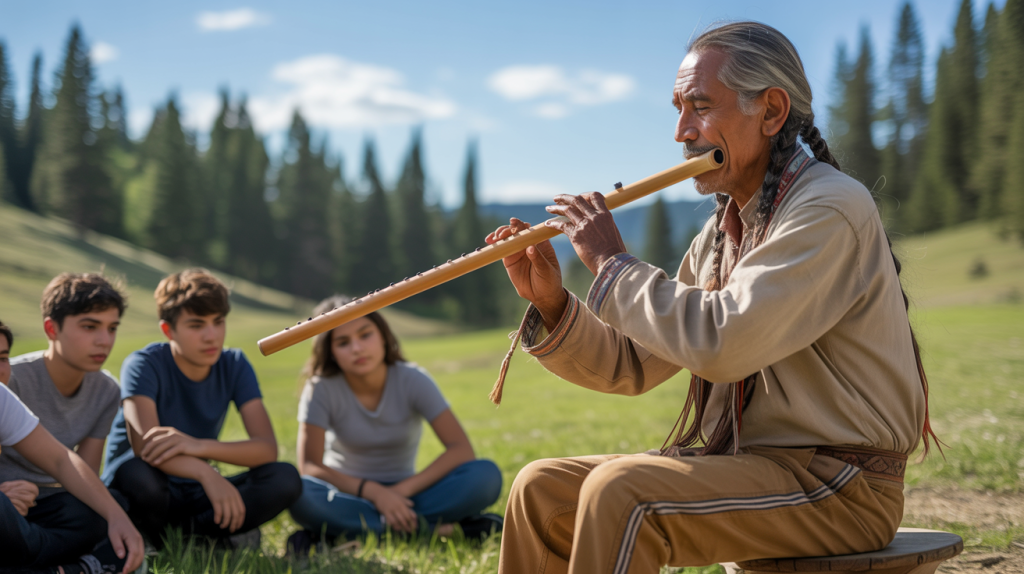
Understanding Cultural Sensitivity and Appropriation
The growing global interest in Native American drone flutes brings both opportunities and responsibilities for players, makers, and enthusiasts.
Approaching this traditional instrument with appropriate cultural sensitivity requires understanding the difference between appreciation and appropriation while honoring the living traditions from which these instruments emerge.
Cultural context awareness begins with recognizing that Native American flutes, including drone variations, are not simply musical instruments but carriers of spiritual and cultural significance.
Many tribal traditions view flute playing as a form of prayer or spiritual practice, with specific protocols and understandings that extend far beyond technical proficiency.
Non-Native players can honor these traditions by approaching the instrument with respect and seeking to understand its cultural context.
Appropriation versus appreciation distinctions matter significantly in how we engage with indigenous musical traditions.
Appreciation involves learning about the cultural context, supporting authentic makers, and acknowledging the instrument’s origins.
Appropriation occurs when cultural elements are extracted from their context for personal benefit without regard for their significance or impact on indigenous communities.
Educational responsibility extends to sharing knowledge about the instrument’s cultural significance when teaching or performing for others.
This includes providing accurate historical context, acknowledging the specific tribal traditions that contribute to drone flute development, and avoiding stereotypical or romanticized presentations that reduce complex cultures to simple musical elements.
Spiritual considerations require particular sensitivity, as many Native American traditions view music-making as inherently spiritual activity.
Non-Native players should approach the instrument’s meditative and healing qualities with appropriate humility, recognizing that these effects emerge from specific cultural understandings rather than universal musical properties.
Supporting Authentic Native American Artisans
Economic support for authentic Native American flute makers represents one of the most direct ways to honor indigenous traditions while ensuring their continuation for future generations.
This support requires understanding how to identify authentic makers and the broader impacts of purchasing decisions.
Tribal enrollment and authenticity provides the clearest marker of authentic Native American craftsmanship, though not all authentic makers are tribally enrolled.
Many experienced makers can provide information about their cultural background, training, and connection to flute-making traditions.
This transparency distinguishes authentic artisans from commercial manufacturers appropriating indigenous designs.
Economic impact considerations extend beyond individual purchases to broader questions of how global interest in Native American flutes affects indigenous communities.
Supporting authentic makers provides economic opportunities while preserving traditional skills, but only when conducted through relationships that respect indigenous rights and cultural protocols.
Maker relationships can develop into meaningful cultural exchanges that benefit both artisans and players.
Many authentic makers welcome questions about their work and cultural traditions, providing opportunities for deeper understanding that goes beyond simple commercial transactions.
These relationships should be approached with respect for the maker’s time and cultural boundaries.
Avoiding commercial exploitation requires vigilance against mass-produced instruments marketed with indigenous imagery or claims of authenticity.
These products typically provide poor musical quality while appropriating cultural symbols for commercial benefit without supporting indigenous communities.
Preserving Traditions While Enabling Innovation
The challenge of maintaining traditional authenticity while allowing for musical and technical innovation reflects broader questions about how living cultures adapt to contemporary circumstances. This balance requires ongoing dialogue between tradition holders and contemporary practitioners.
Traditional knowledge preservation involves documenting and maintaining the specific techniques, materials, and cultural understandings that define authentic Native American flute traditions.
This work requires collaboration between elder makers, cultural institutions, and contemporary practitioners to ensure that essential knowledge transfers to new generations.
Contemporary adaptation allows traditional instruments to find relevance in modern musical contexts while maintaining their cultural integrity.
This might involve developing new playing techniques for contemporary musical styles or creating instruments suited to modern performance contexts while preserving traditional construction principles.
Cross-cultural dialogue between Native and non-Native players can foster mutual understanding and respect while expanding the instrument’s reach.
These conversations require genuine commitment to learning and cultural sensitivity from non-Native participants, along with willingness from Native tradition holders to share appropriate aspects of their cultural knowledge.
Future sustainability depends on creating economic and cultural conditions that support continued traditional flute making while allowing for appropriate innovation and adaptation.
This requires ongoing support for indigenous artisans, cultural education programs, and respectful engagement from the global community of players and enthusiasts.
Conclusion: Embracing the Sacred Sound
The Native American drone flute stands as more than a musical instrument—it represents a bridge between ancient wisdom and contemporary understanding, between individual expression and cultural tradition, between the earthly and the spiritual.
Through our exploration of its history, construction, playing techniques, and cultural significance, we’ve discovered an instrument that offers profound possibilities for musical, meditative, and spiritual development.
The journey into Native American drone flute playing begins with technical learning but extends far beyond mechanical proficiency.
The instrument’s dual-chamber design creates not just harmonic complexity but symbolic representation of balance, duality, and integration that characterizes much of indigenous wisdom.
Whether approached as a meditation tool, a musical instrument, or a cultural bridge, the drone flute offers experiences that can transform both player and listener.
For those called to explore this remarkable instrument, the path forward requires commitment to both musical development and cultural sensitivity.
Supporting authentic Native American makers ensures that your musical journey contributes to the preservation of living traditions while providing you with an instrument capable of delivering the transformative experiences that make drone flute playing so compelling.
The growing global community of Native American drone flute enthusiasts represents both opportunity and responsibility.
As interest in the instrument expands beyond its cultural origins, we must ensure that this growth serves to honor and preserve indigenous traditions rather than appropriating them for purely personal benefit.
This requires ongoing education, respectful engagement with tribal communities, and commitment to authentic instruments and teachers.
Whether you’re drawn to the drone flute for its meditative qualities, its unique musical possibilities, or its cultural significance, the instrument offers a lifetime of exploration and discovery.
The path of learning involves not just developing technical skills but cultivating the awareness, sensitivity, and spiritual openness that allow the instrument’s deeper qualities to emerge.
The Native American drone flute tradition continues to evolve, shaped by both traditional knowledge holders and contemporary practitioners who approach the instrument with appropriate respect and dedication.
By joining this community with humility, curiosity, and commitment to cultural sensitivity, you become part of a living tradition that connects us to both ancient wisdom and future possibilities.
Take time to find the right instrument, the right teacher, and the right approach for your personal journey with the drone flute.
Allow the instrument to guide your learning as much as you guide its playing. Most importantly, remember that every breath through this sacred instrument carries the opportunity to connect with something larger than ourselves—the timeless wisdom of indigenous cultures and the universal human capacity for spiritual expression through sound.
The drone flute awaits your exploration, ready to share its ancient secrets and contemporary possibilities with all who approach it with open hearts and respectful minds.
Your journey into this remarkable musical tradition begins with a single breath, a single note, and a commitment to honoring the cultures that have preserved this gift for future generations to discover and cherish.
Source: History of Native American Flute
Related Post: Native American Flute






